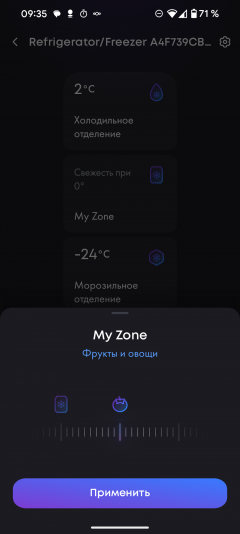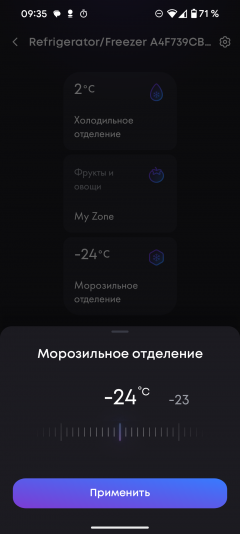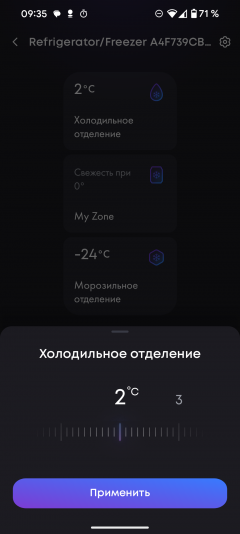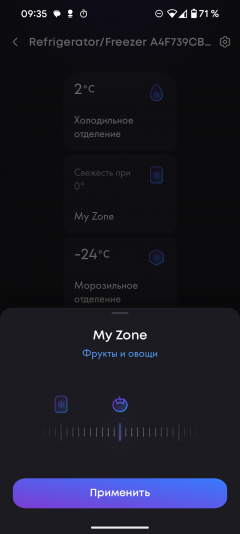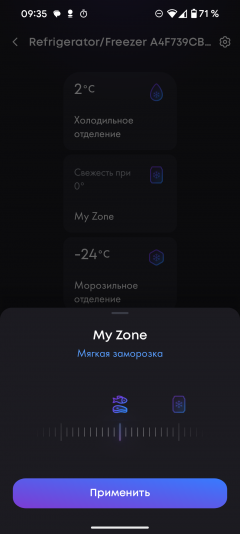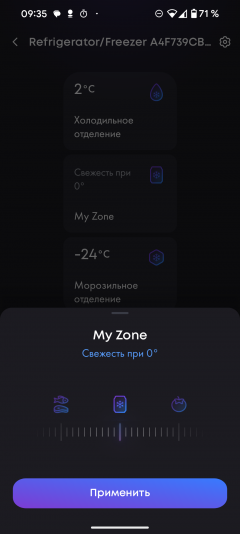How many times have we tried to squeeze one large pot into the refrigerator, moved the shelf, and were upset that the rest of the space on it was wasted...
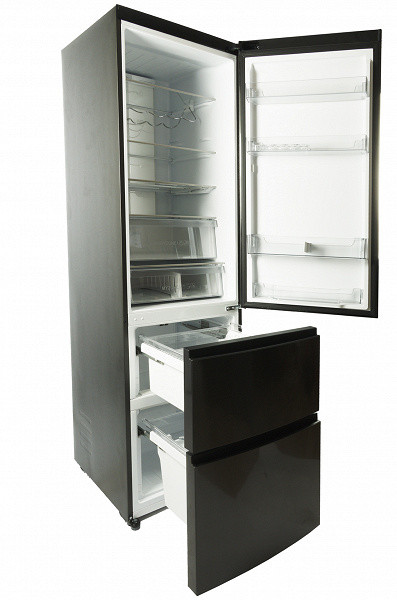
The first thing that caught our attention when examining the Haier A4F739CBXGU1 was its unusual third shelf. Read our review to find out how it helps solve capacity issues.
Characteristics
| Manufacturer | Haier |
|---|---|
| Model | A4F739CBXGU1 |
| Type | three-chamber refrigerator |
| Country of origin | Russia |
| Guarantee | 5 years |
| Service life * | 7 years |
| Compressor type | inverter |
| Total useful volume | 389 l |
| Volume of the refrigeration chamber | 286 l |
| Freezer capacity | 103 |
| Energy efficiency class | A++ |
| Refrigeration chamber cooling technology | No Frost |
| Freezer Cooling Technology | No Frost |
| Control system | electronic |
| Remote control via Wi-Fi | There is |
| Climate class | SN-T |
| Number of shelves on the door | 4 |
| Capacitor | hidden |
| Backlight | Tower LED |
| Folding shelf | There is |
| Total number of shelves | 3 |
| Folding shelf | There is |
| Folding wine rack | There is |
| Fruit and vegetable box | There is |
| MyZone Adjustable Compartment | There is |
| Adjustable HumidityBox | There is |
| Reversible doors | There is |
| Freezer Lighting System | LED |
| Freezer compartments | 2 |
| Refrigerant type | R600a |
| Noise level | 36 dBA |
| Weight | 84 kg |
| Dimensions (W×H×D) | 595×2000×682 mm |
| Length of network cable | 1.6 m |
* Contrary to popular belief, this is not a period after which the device will necessarily break down. However, after this period, the manufacturer ceases to bear any responsibility for its functionality and has the right to refuse to repair it, even for a fee.
Equipment
The Haier A4F739CBXGU1 refrigerator is packed in a cardboard box and foam plastic, additionally protected by nylon straps. The packaging contains a large logo, manufacturer's contact information and shipping instructions, but there is little information itself. The model index and serial number are indicated on a small sticker on one side.
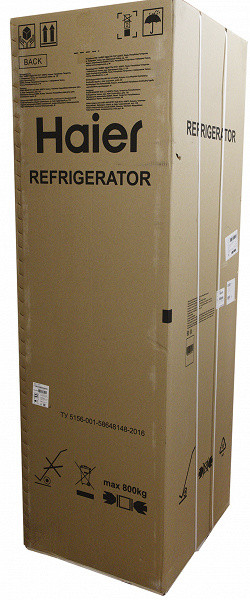
The refrigerator comes with:
- egg tray
- ice cube
- three plastic dividers: for the freshness zone drawers, freezer compartment and door shelf
- door reversing kit
- user manual
- warranty card
- energy efficiency sticker
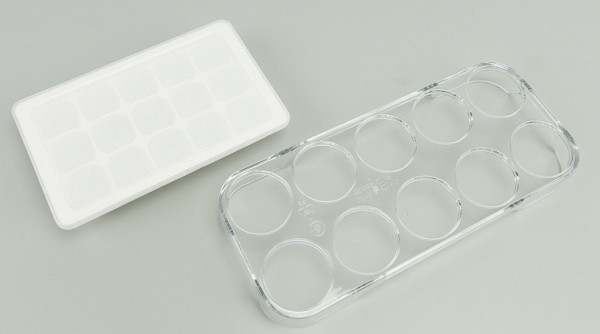
At first glance
The Haier A4F739CBXGU1 refrigerator is equipped with three chambers: the upper part with a classic hinged door is intended for the refrigeration compartment, and the freezer is divided into two zones with pull-out drawers.
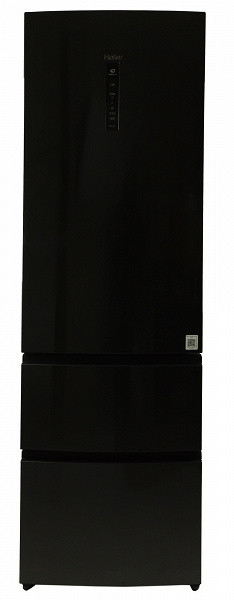
The smooth front panels of the door and drawers are finished in black stainless steel, which gives an elegant and solid look, ideal for most modern kitchen interiors. The manufacturer offers this model in black-steel, graphite and dark brown colors.
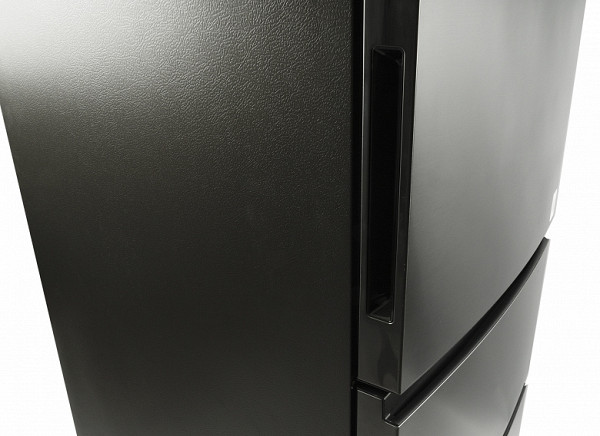
The smooth glossy coating of the front panels creates a metallic effect, changing color depending on the lighting and viewing angle: in bright light, the refrigerator looks gray-steel, and in the semi-darkness — black.
The niche handles are located on the right and left ends of the door, which allows the door to be hung on the left side in accordance with the user's needs.
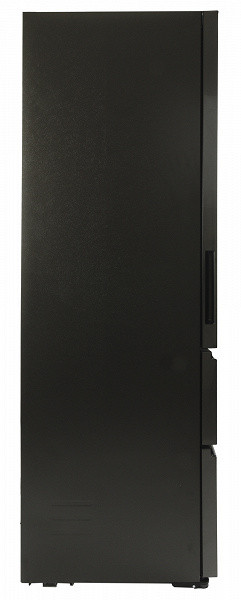
The side walls of the refrigerator have a textured surface that resembles leather. Adjustable front feet allow the refrigerator to be precisely leveled to the floor, while rear casters allow the heavy unit to be easily moved without damaging the surface.
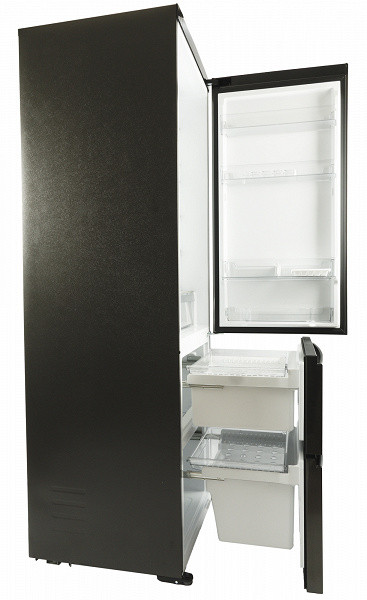
The drawers of the freezer compartment differ significantly in size: the space behind the lower one is reserved for a niche for the compressor unit.
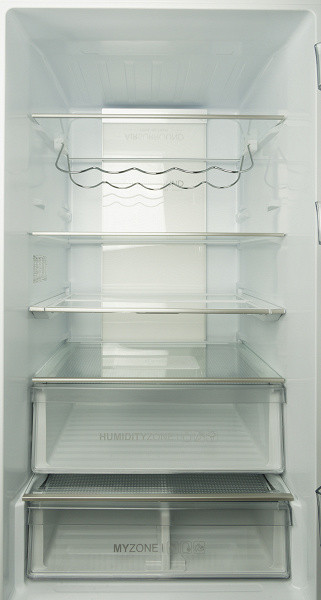
The refrigeration compartment has three glass shelves of different designs. The top shelf has a folding bottle holder, the second is traditional and allows you to adjust the height, and the third is folding. The fourth shelf is a glass cover of the freshness zone.
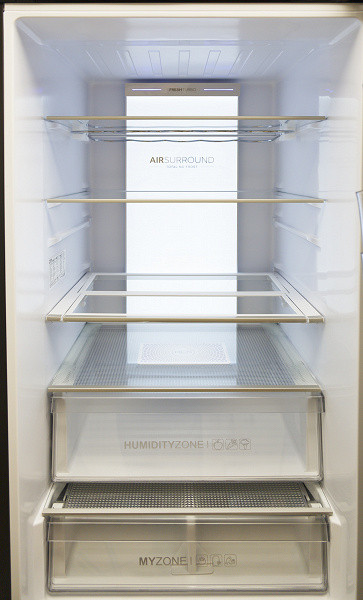
The rear wall of the refrigerator is mainly occupied by the Tower LED ventilation column, which is integrated with the LED panel. This combination provides uniform, shadow-free illumination of the entire interior space and gives the device a modern look.
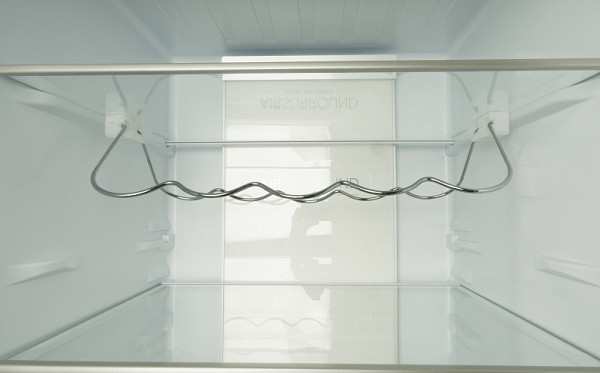
Under the top shelf there is a folding metal holder designed for horizontal storage of five containers.
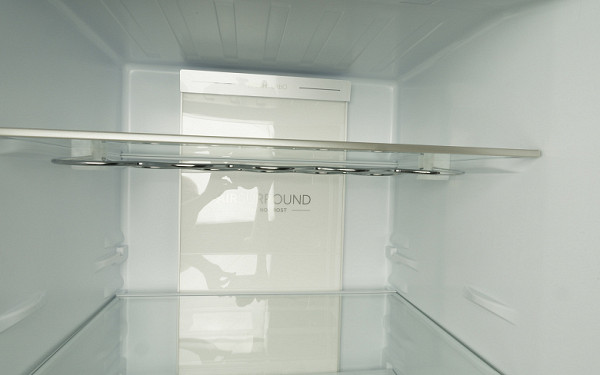
When there is no longer a need to cool bottles, the design folds up and takes up minimal space, making it much more convenient than traditional removable wire baskets.
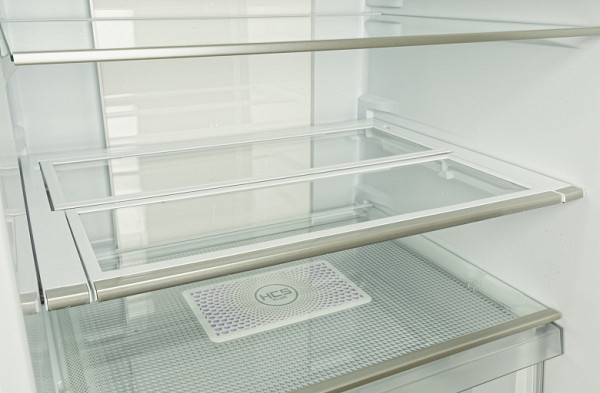
We didn’t see anything remarkable in the design of the second shelf, but the third one surprised us with its unusually wide range of possibilities.
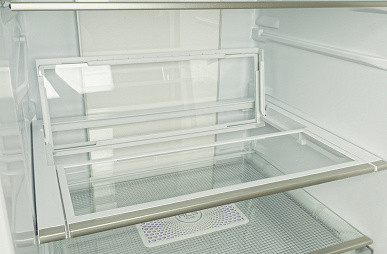
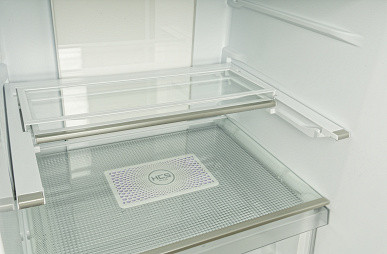
The design consists of two parts: the back, which rotates 90°, and the front, which can slide and rotate. If you need to store tall items, such as large bottles, the back can be raised, leaving the front for horizontal storage. It is also possible to slide the front to conveniently place bottles or pots in the front.
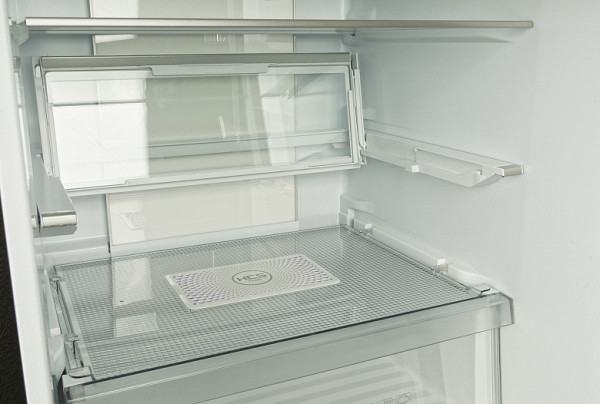
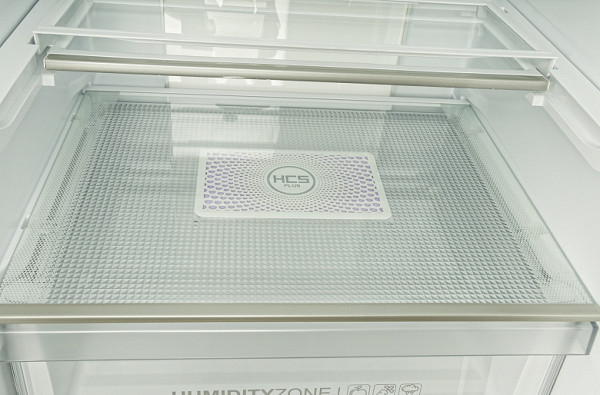
The two drawers in the refrigeration compartment have different climate settings. The upper drawer, called HumidityZone, is designed to store fresh vegetables and fruits, creating a freshness zone. It has a double lid: the glass top layer acts as the bottom shelf, and the plastic surface with a membrane underneath regulates the humidity level.
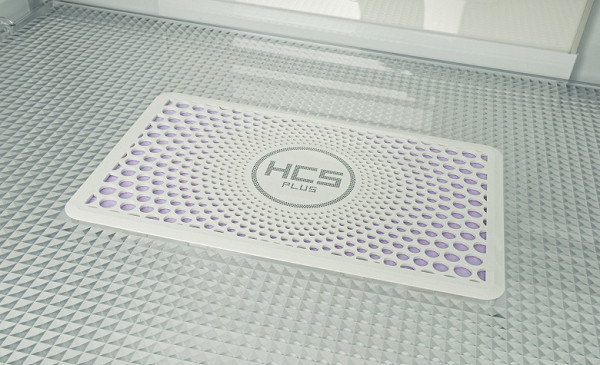
According to the manufacturer, the respiratory membrane in the design removes excess moisture when its level exceeds 90%, and accumulates moisture when the air is too dry. Thanks to this, vegetables and fruits are stored under optimal humidity and temperature conditions, which helps to preserve their freshness for a long time.
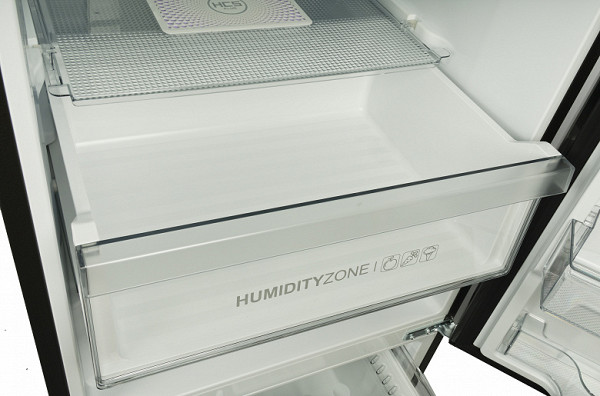
The HumidityZone and MyZone (bottom) drawers have a clear front panel for easy visibility of their contents. The top drawer does not have any dividers or organizers.
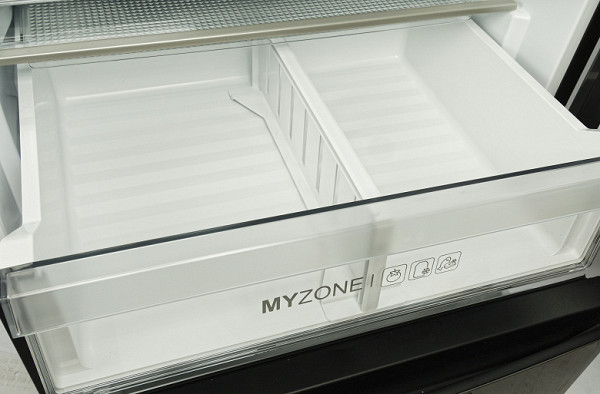
The bottom drawer is designed to store fresh food such as chilled meat, poultry or fish at a temperature around zero degrees. The temperature in this section of the refrigerator can be adjusted separately. There is also a removable plastic divider for easy storage organization.
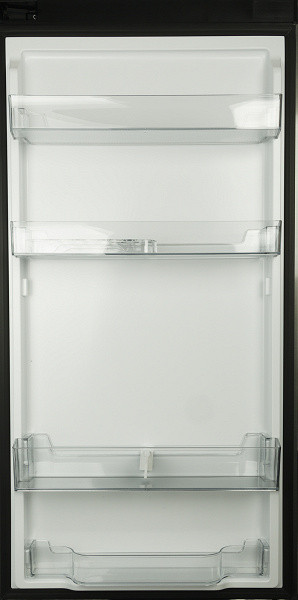
The refrigerator compartment door has four shelves made of slightly greyish transparent plastic. The top and two bottom shelves have a fixed placement, while the second shelf can be installed in one of two positions.
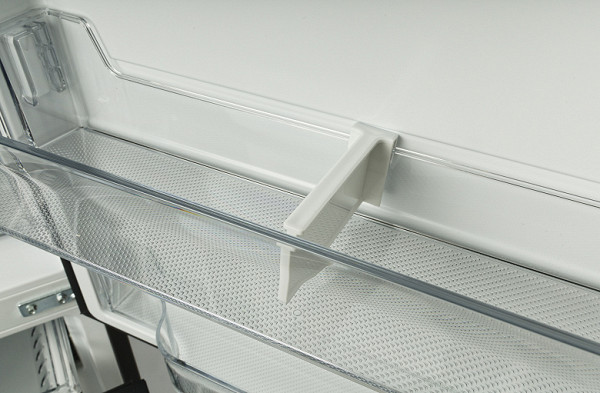
Haier designers have paid attention to the organization of storage on the shelves, offering a simple but functional plastic divider in the set. Unfortunately, many other manufacturers often miss such important details.
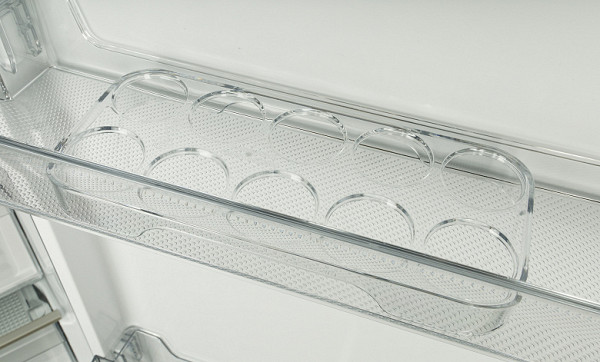
The included stand holds ten pieces, rather than the traditional half-dozen we've seen on similar models from other brands.
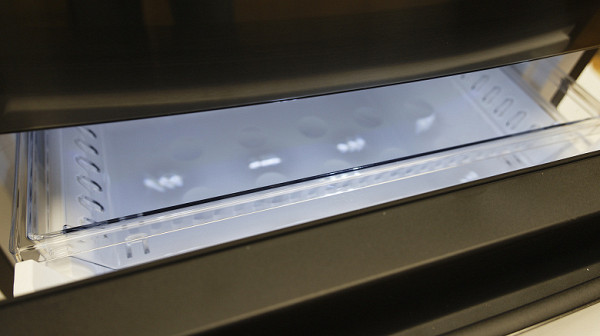
This model is equipped with freezer compartment lighting. When any of the drawers is pulled out, bright white LEDs turn on at the bottom of the door. This system does not cause unnecessary heating and allows you to easily find the necessary products even in complete darkness.
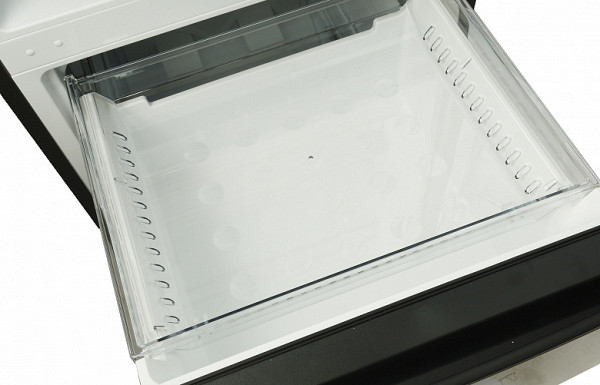
The freezer compartment drawers are protected by removable plastic shelves, which provide convenient storage and freezing of small flat items such as pizza boxes, trays of fresh berries or homemade dumplings.
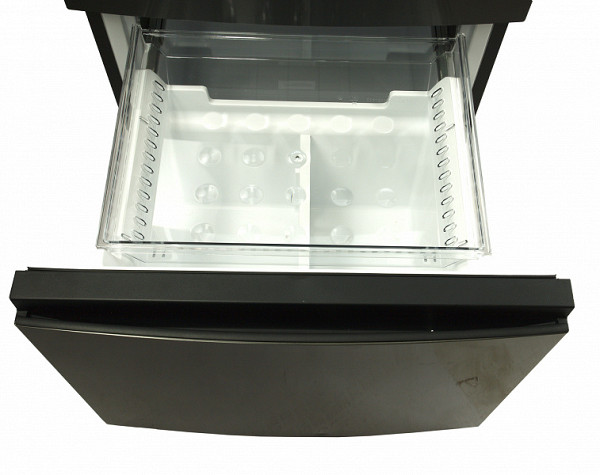
Both shelves have holes to allow free circulation of cold air.
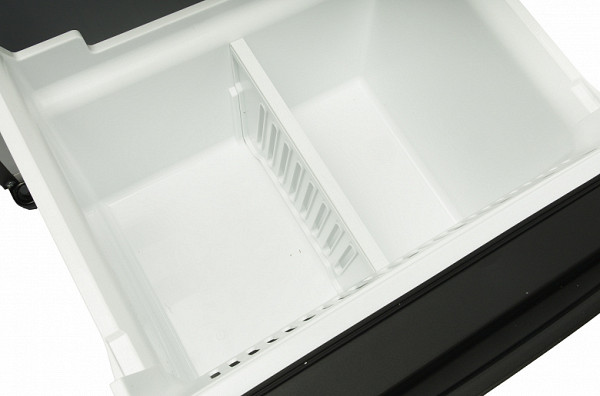
The bottom drawer comes with a plastic organizer with a fixed position: the container can be divided in half.
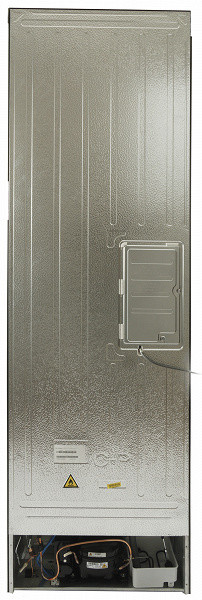
The back wall of the refrigerator is made of unpainted metal. In the lower part there is a niche for the compressor unit, and behind the hatch in the middle there is the control electronics.
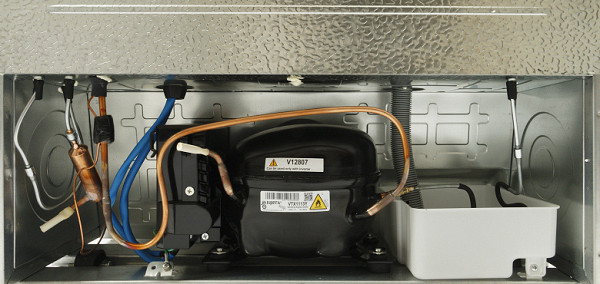
The design of this model uses the Jiaxipera V12807 inverter compressor.
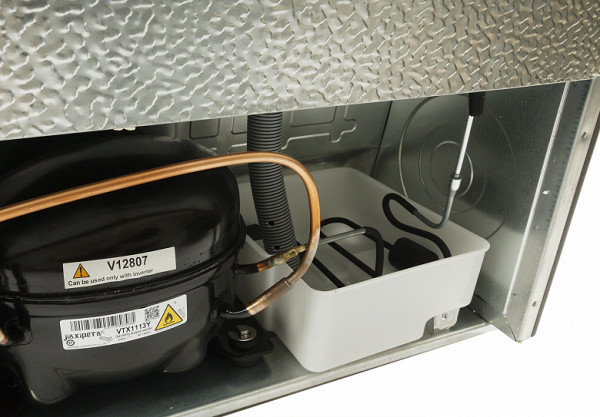
Next to the compressor there is a plastic tray, to which a corrugated tube is connected. The condensate formed during operation flows into this container, where it is heated by a coil and then evaporates.
Instructions
The user manual is in A5 format and printed on thin yellowish paper. The quality of the printing is rated as average: small font and not the best quality illustrations make it difficult to read. The combination of a high-tech and expensive device with obvious savings on documentation looks a bit strange.
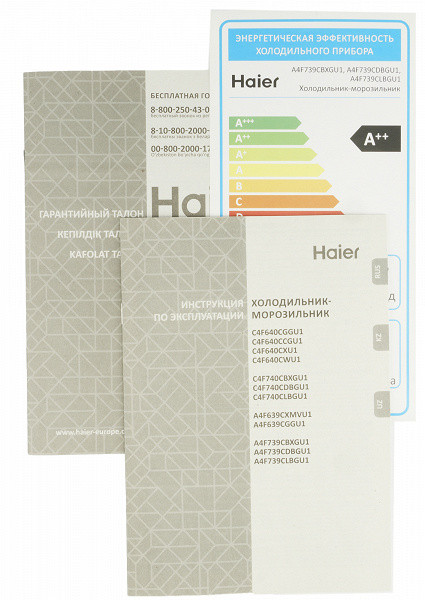
The manual is written in three languages: Russian, Kazakh and Uzbek. The Russian version takes up the first seven pages out of 26, and the last two pages are devoted to the description of hanging the door from the right side to the left.
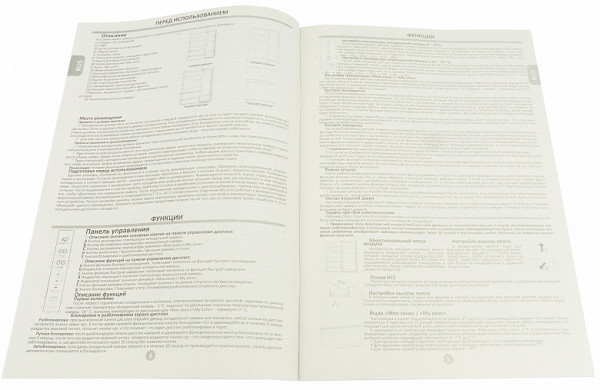
As with many manufacturers of large household appliances, the manual covers several similar models from the same line — in this case, twelve. All the differences between them are described in detail.
The manual contains brief information on how to operate the refrigerator, as well as recommendations for its operation and maintenance. The documentation set also includes a warranty card and a sticker with information on the energy efficiency of the device.
Control
The control panel is made of smooth black plastic and is located on the refrigerator compartment door. Under the EcoPlus logo is a dual LED display that shows the set temperatures for the refrigerator and freezer.
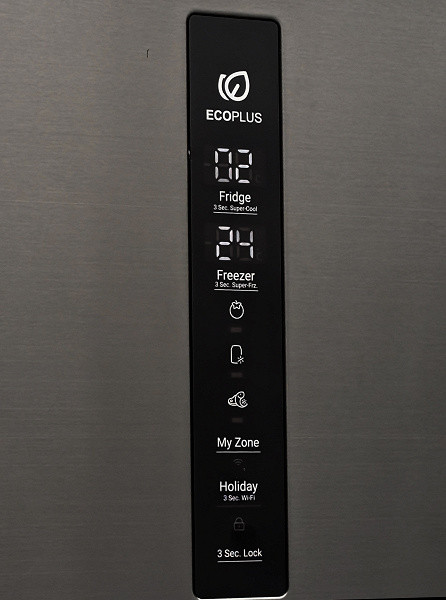
The «Fridge» button regulates the temperature in the refrigerator compartment, allowing you to set it in the range from +2 to +8 °C in 1 °C increments. A long press activates the fast cooling function, in which the refrigerator operates at maximum power for 3 hours, after which it returns to the previously set settings.
The «Freezer» sensor controls the temperature in the freezer, offering a range from -16 to -24 °C in 1 °C increments. A long press activates the fast freezing mode, maintaining the minimum temperature for 50 hours, after which the device returns to the previous settings.
The «My Zone» button allows you to select one of three preset temperature modes for the freshness zone: «Fruits and vegetables», «Freshness at 0 °C» and «Easy freezing».
The «Holiday» sensor switches on the holiday mode, turning off the cooling of the refrigerator compartment and maintaining the temperature in the freezer at -17 °C. A long (3 seconds) press on this sensor activates synchronization with the mobile application.
The lower button is responsible for locking the panel from children and is switched on by a long (3 seconds) touch. After 5 seconds of inactivity, the control panel switches off and goes into standby mode.
Control from smartphone
To control Haier home appliances, the manufacturer offers the evo application of its own design.

The app has been downloaded over 100,000 times. At the time of writing, it has a very impressive rating: 4.8 out of 5 possible.
To work properly, the program requires access to the device's location information. You also need to register with a verified email address or phone number to use the application.

It is also recommended to allow the application to send notifications.
To activate the pairing mode, you need to turn on the refrigerator and hold the «Holiday» button for 3 seconds until you hear a beep. At this time, the «Wi-Fi» indicator will start flashing.
If all steps are followed correctly, the refrigerator will appear on the main screen of the application, ready to connect. When trying to connect, for some reason the device requests access to contacts and call log, which should not be allowed. However, entering the SSID and password from your Wi-Fi network will be required.
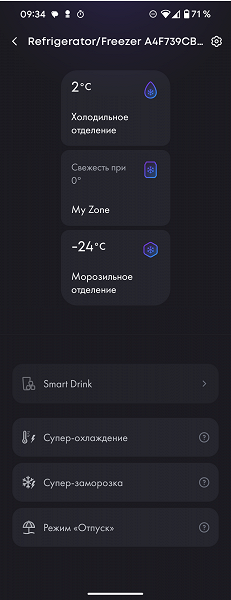
If all steps are followed correctly, the refrigerator will appear on the main screen of the application, ready to connect. When trying to connect, for some reason the device requests access to contacts and call log, which should not be allowed. However, entering the SSID and password from your Wi-Fi network will be required.
The temperature in the refrigerator compartment is adjusted in the range from +2 to +8 °C in 1 °C increments, and in the freezer – from -16 to -24 °C in 1 °C increments: everything is the same as on the control panel.
The temperature in the freshness zone can be set to “Soft Freeze” (slight minus), “Freshness at 0 °C” or “Fruits and Vegetables” (above zero) mode.
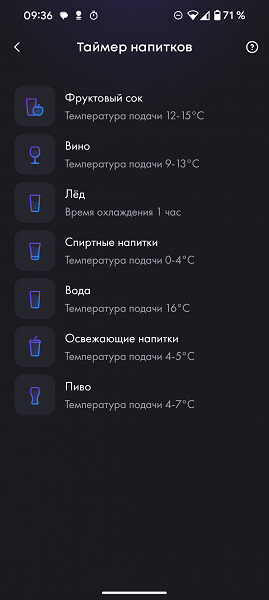
The Drink Timer feature is not available on the dashboard — it is only available in the app. This option allows the user to quickly cool the selected drink to the optimal temperature, and the app will notify when it is ready to drink for the party.

The user can select the type of drink (fruit juice, wine, spirits, water, soft drinks or beer), packaging material (plastic, tin, glass or cardboard), volume (150 ml to 1 l), initial temperature (room temperature or warm) and storage location (refrigerator compartment, MyZone drawer or freezer). The timer can then be started by pressing the «Start» button. The app calculates the optimal cooling time based on the entered parameters and the current temperature of the device, sending a push notification when the drink reaches the desired temperature.
The settings page provides information about the refrigerator firmware version, as well as the ability to update it. Here you can check the network settings, get an extended warranty certificate provided by the manufacturer upon registration, download an electronic version of the user manual, leave a request for technical service or contact technical support.
However, the application, unfortunately, does not provide assistance in organizing the storage of products: it will not remind you of expiring expiration dates or offer advice on making a shopping list.
Operation
When choosing a place to install the refrigerator, it is important to place it on a flat and solid surface. Avoid direct sunlight on the case, and ensure that interior items do not interfere with the opening of the door and the sliding of the drawers.
After installation, adjust the case horizontally using the front legs. A slight backward tilt is acceptable, so the door will close easier. If necessary, the door can be hung on the right side — all necessary elements are included in the kit.
Before the first switch-on, remove all packaging materials, including adhesive tape and soft pads holding the shelves and accessories.
Although the manufacturer does not provide special recommendations for switching on, based on the experience of similar devices, you should wait a few hours after transportation so that the refrigerant has time to properly distribute throughout the system.
The refrigerator compartment is equipped with an open door alarm system: if it remains slightly open, the refrigerator will begin to emit a quiet signal after three minutes. Initially, the buzzer will sound every 10 seconds, and after 7 minutes — every five seconds.
There is no alarm in the freezer compartment, but the design of the guides with soft-close mechanisms makes it unnecessary, as they automatically push the drawers.
In the event of a power outage, the refrigerator remembers the user settings and returns to them after power is restored.
The side walls, where the heat exchangers are located, do not heat up too much during operation. We also provide photographs of the device in operation in the infrared range.
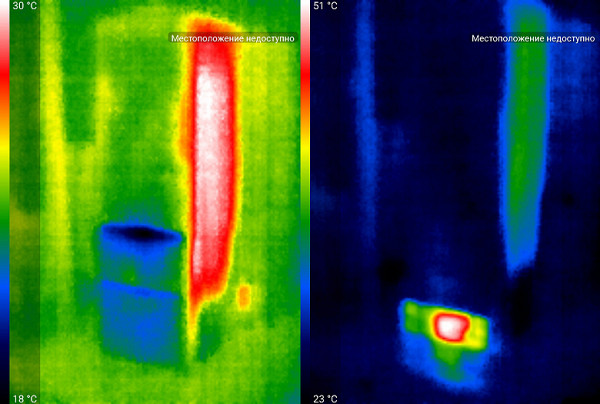
Front/left and right/back of the refrigerator when it is on; the compressor is clearly visible when it is running
As in all previous reviews, we not only measure the capacity of the refrigerator compartment with a ruler and tape measure, but also demonstrate its capacity using more visual examples.
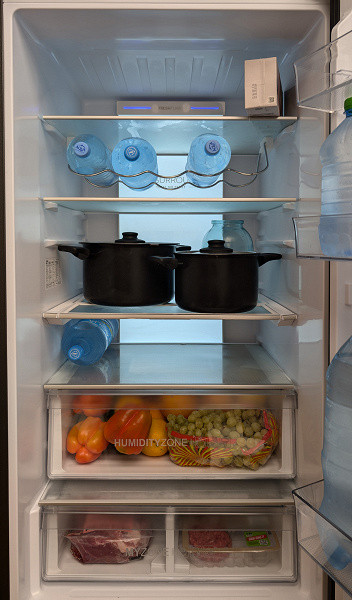
The depth of the shelves allows you to place standard plastic bottles up to 2 liters on them. They do not interfere with the door closing.
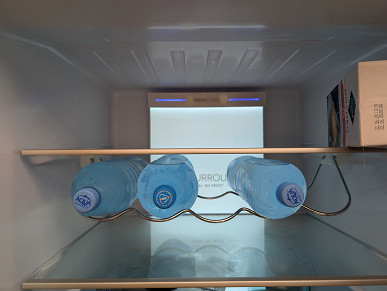
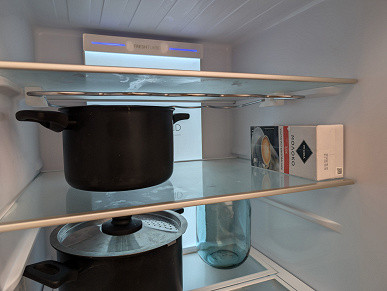
The metal bottle holder can hold up to five two-liter containers. When not in use, it can be folded away, allowing use of a second shelf with two fixed positions.
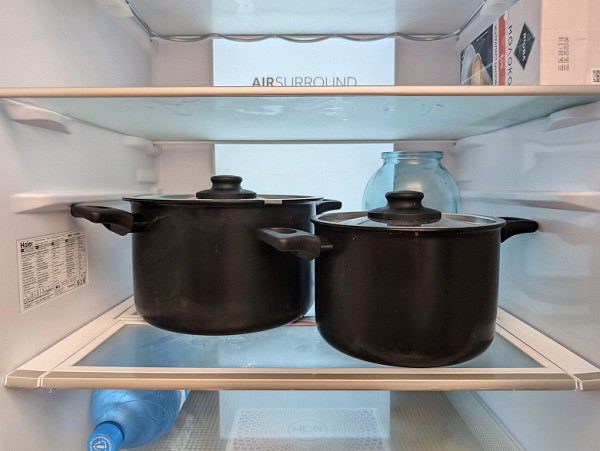
The height of the third shelf allows for the placement of two- and three-liter pots and even three-liter jars.
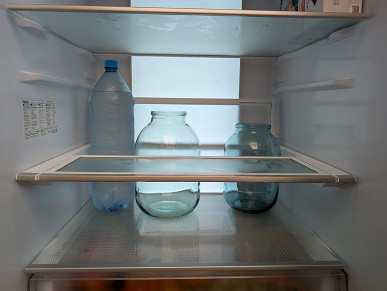
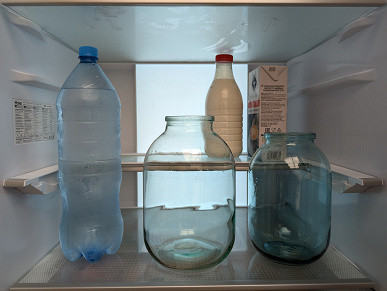
This shelf is transformable: it can be completely folded or left half for tall products, placing them in the front or back. The other half is conveniently used for storing less bulky items, such as liter bottles of milk.
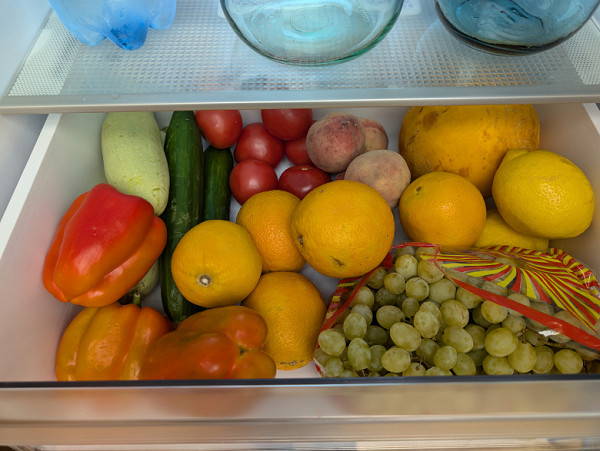
The capacity of the vegetable drawer allows you to store a supply of fresh produce for several days: as we can see, even a small melon fits in here easily.
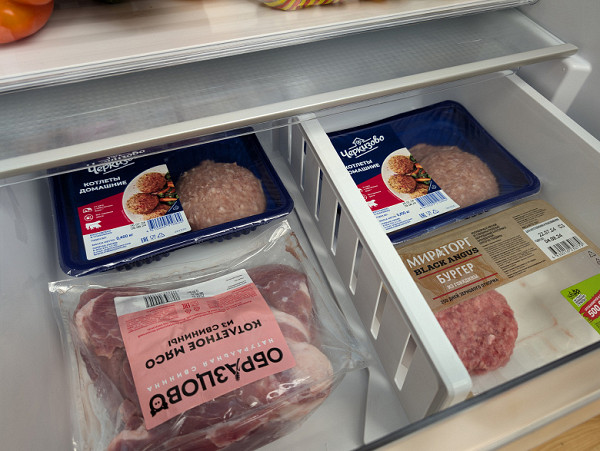
The capacity of the vegetable drawer allows you to store a supply of fresh produce for several days: as we can see, even a small melon fits in here easily.
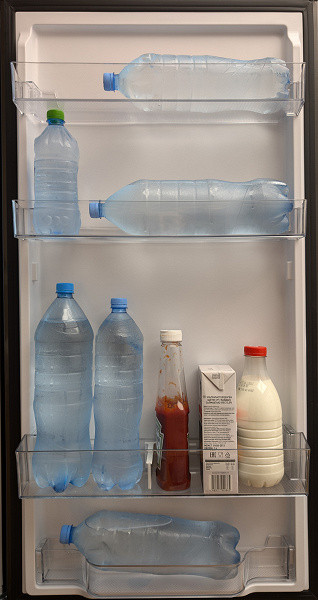
The width of the three upper shelves allows you to place plastic bottles up to 2 liters on them. Dairy product packages or egg cups are also conveniently placed here. The lower shelf, in turn, is designed to store small items such as bottles of sauces, medicines, or boxes of yogurt or sour cream starter.
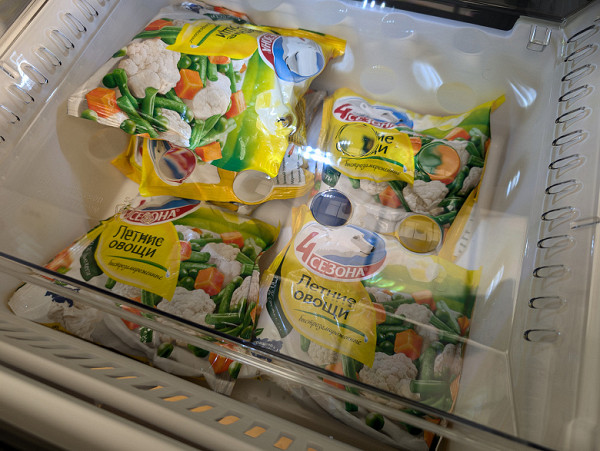
The top drawer of the freezer is wide enough to hold four standard 400-gram packages of frozen vegetables: three at a time, or up to four if stacked tightly. In addition, four more bags can be placed on the clear plastic tray that sits above the drawer.
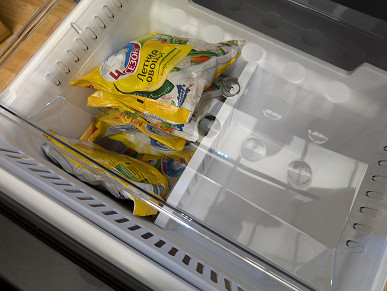
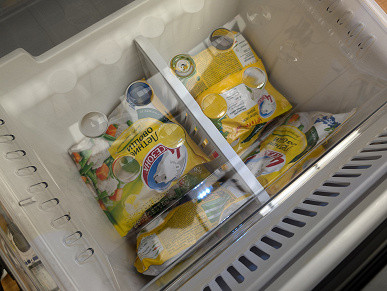
The depth of the lower drawer is slightly less (as we remember, the refrigeration unit is located behind it), but the height is noticeably greater than that of the upper one.
Care
To avoid unpleasant odors, the refrigerator must be cleaned regularly. The manufacturer recommends using a soft cloth or sponge soaked in warm water. After wet cleaning, it is important to thoroughly wipe all interior surfaces dry.
When cleaning the appliance, avoid hard or wire brushes, abrasive materials and aggressive chemicals. It is better to use specialized detergents for refrigerators.
The refrigerator and freezer compartments defrost automatically, and manual control is not required.
If you plan to take a long break from using the device, the manufacturer advises disconnecting it from the network and leaving the door slightly open to prevent the appearance of unpleasant odors.
Our measurements
The useful volume of the refrigerator is defined as the total volume of all drawers and shelves, which is calculated based on the measurements of the interior spaces.
Therefore, our measurement results will never coincide with the data provided by manufacturers, which indicate the full volume of the compartments, while we calculate the useful volume.
The volume of the freezer compartment drawers we measured is (40×37×20) + (40×28×29) = 29600 + 32480 = 62080 cm³ or 62 liters.
The useful volume of the refrigerator compartment shelves, according to our data, is 39×51×71 = 141219 cm³ or 141.2 liters. The HumidityZone vegetable drawer has a volume of 35×49×18 = 28980 cm³ (29 liters), and the volume of the MyZone drawer is 36×44×12 = 19008 cm³.
Adding the volume of the door shelves (47232 cm³ + 6048 cm³), we get the total useful volume of the refrigerator compartment: 242487 cm³, or 242.5 liters.
We measured the energy consumption of the device in maximum power mode for 3 days. During this time, the refrigerator consumed 5.227 kW h, which corresponds to the maximum daily energy consumption of 1.759 kW h — quite a lot for such a voluminous device.
The noise level when the compressor is operating does not exceed 39 dB (A).
| Useful capacity of the freezer compartment | 62 l |
|---|---|
| Useful capacity of the refrigerator compartment | 243 l |
| Maximum recorded power consumption | 194 W |
| Daily energy consumption in maximum mode | 1,759 kWh |
| Noise level when the compressor is running | 39 dB(A) |
To evaluate the performance of refrigerators and freezers, as well as the thermal insulation of their housings, our laboratory has developed a hardware and software complex based on the Arduino mini-computer and DS18B20 digital sensors. These sensors operate in the temperature range from -55 to +125 °C and provide measurement accuracy of ±0.5 °C in the range from -10 to +85 °C.
To avoid the influence of the processor's heat generation on the microclimate inside the chamber and on the measurement results, the device is placed outside the refrigerator. The sensors are connected to the mini-computer using three wires with a cross-section of 0.3 mm², which are additionally sealed at the passage under the door seal.
Freezer Dimensions
Three hermetically sealed temperature sensors were placed in three four-liter plastic containers. We filled the containers with water and placed them in the freezer: one container in the top drawer, and the other in the bottom. The sensor capsules were located as close to the center of the containers as possible.
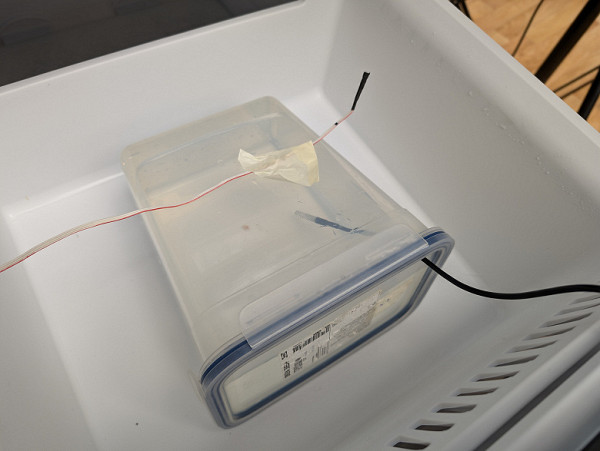
In addition to water temperature sensors, air temperature sensors were also used. We placed them next to the containers in the same boxes, while ensuring that the surface of the sensors did not have direct contact with the elements of the freezer body.
The total volume of frozen ballast was 8 liters.
Refrigerator chamber measurements
To simulate the operation of a loaded refrigerator, we used water ballast in 4-liter containers similar to those used in the freezer test to simulate the operation of a loaded refrigerator. We also placed several plastic bottles of water on the shelves and door of the refrigerator.
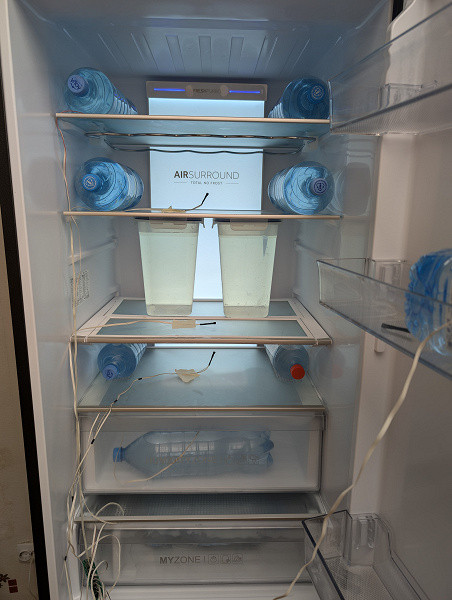
The air temperature inside the refrigeration chamber was measured using seven sensors: four of them were placed on the shelves as close as possible to their geometric center, the fifth and sixth sensors were lowered into the freshness zone drawers, and the seventh was fixed on the shelves of the right door.
The total volume of the cooled ballast was 25 liters.
Operation of the refrigeration chamber
The temperature inside the refrigeration chamber depends not only on the installed cooling capacity, but also on the placement of the product being cooled. We turned on the refrigerator with ballast in the maximum power mode and tracked the temperature changes in the chamber over the course of 24 hours (hereinafter, the shelves will be numbered from top to bottom). The measurement results are presented in the graph.
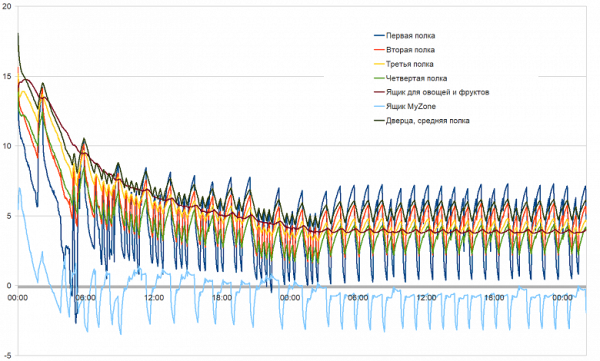
About six hours after switching on, the compressor started to work continuously and then switched to pulse mode. The temperature in all zones stabilized after about 30 hours.
Now let's look at the operation of the device in more detail by enlarging the graph.
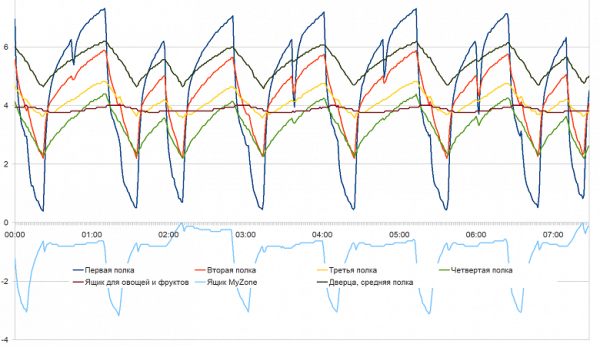
It can be seen that the temperature at most measurement points fluctuates within a relatively wide range.
The microclimate in the HumidityZone drawer is more stable. This zone is not so actively ventilated, so there are practically no changes in humidity and temperature, which helps to preserve the freshness of greens, vegetables and fruits.
In the MyZone drawer, temperature fluctuations are significantly higher, and the average temperature remains negative, as it should be in the «Light Freeze» mode. We remind you that the «Fruits and Vegetables» and «Freshness at 0 °C» modes are also available in this zone.
It is important to emphasize that the presented graphs do not demonstrate the consumer characteristics of the refrigerator, but the features of the refrigeration unit and the circulation of cold air between the chamber zones. You should not be surprised by such, at first glance, significant fluctuations: chilled products have much greater thermal inertia than the air in the chamber, and normally tolerate cyclic temperature changes.
From the consumer's point of view, the average temperature in different zones of the refrigerator is much more important. We measured it over the course of a day on each shelf of the refrigeration compartment in maximum cooling mode and compiled the data we obtained into a table.
| Temperature, °C | Maximum | Minimum | Average |
|---|---|---|---|
| First shelf | +7.3 | +0.4 | +4.3 |
| Second shelf | +5.9 | +2.2 | +4.3 |
| Third shelf | +4.8 | +3.6 | +4.1 |
| Fourth shelf | +4.4 | +2.2 | +3.3 |
| Fruit and vegetable box | +4.0 | +3.8 | +3.9 |
| MyZone Box | +0.0 | -3.2 | -1.1 |
| Door, middle shelf | +6.2 | +4.6 | +5.4 |
It is interesting to note that the average temperature in all measured zones is almost the same. Among similar devices that we have recently reviewed, this refrigerator demonstrates, perhaps, the most stable microclimate.
Freezer operation
To evaluate the freezing capacity of the refrigerator, we placed containers of room-temperature water in both drawers of the freezer and turned on the maximum cooling mode. The results of water and air temperature measurements are presented in the graph below.
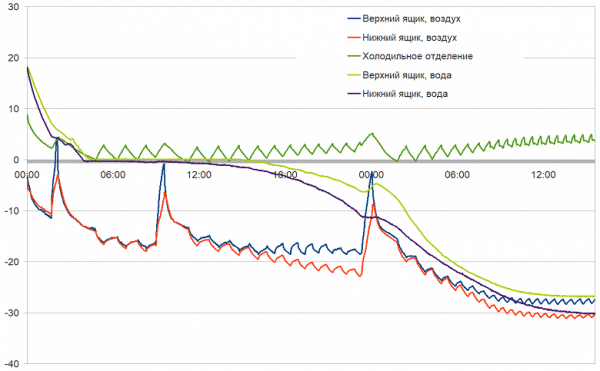
The water in the middle and bottom boxes froze almost simultaneously, after about 13 hours. After that, the ice temperature continued to decrease, reaching the set minimum temperature after 32 hours from the start of the test.
Defrosting the refrigerator
To evaluate the thermal insulation of the case and to find out how long the unit stays cold when unplugged, we turned off the pre-cooled refrigerator with ballast and observed the temperature change.
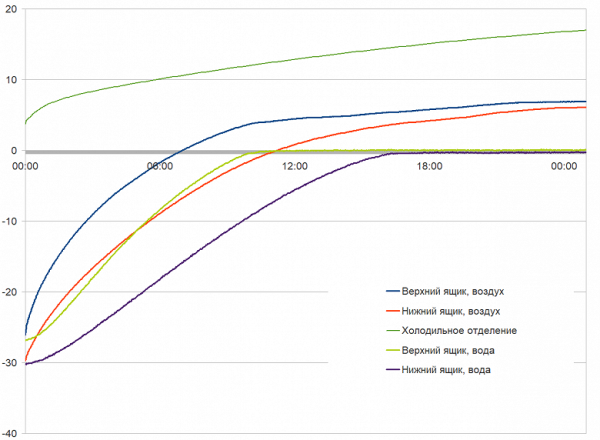
The graph shows that the thermal insulation of the lower drawer was significantly better: the temperature in it crossed the zero mark four hours later than in the upper one. The ice in the upper drawer began to melt 9 hours after the power was turned off, while the lower container retained the cold for almost 16 hours.
The manufacturer does not indicate in the technical specifications the duration of temperature retention inside the device. Our experiment showed that the thermal insulation of the case is acceptable, but not outstanding: we have seen models that retain the cold much better.
Electricity consumption
The energy consumption graph shows a curve with a complex configuration: the modern inverter compressor used in this model allows flexible control of the device's power.
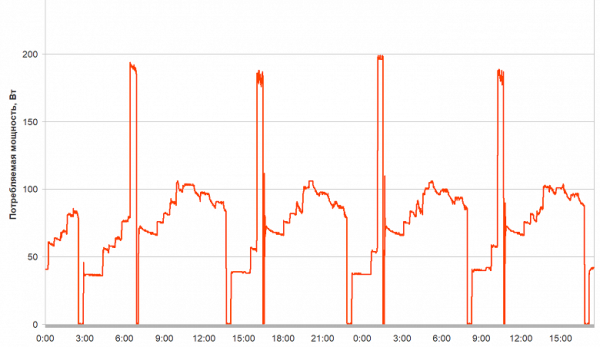
In normal operation, the oscillation period is slightly less than 12 hours. The maximum power consumption of the device, according to our measurements, is about 194 W, while the average power is approximately 73 W.
Conclusions
The Haier A4F739CBXGU1 refrigerator has an attractive design and modern construction. The inverter compressor ensures a stable temperature in all areas of the refrigeration and freezer chambers, as well as rapid cooling and freezing of large volumes of products.
The refrigeration chamber includes two freshness zones. The microclimate in the first zone is maintained at an optimal level for vegetables and fruits due to the design of the drawer and a special membrane that regulates humidity. The second drawer is designed for easy freezing of fresh meat, poultry or fish, storing products at zero temperature or can be used as an additional place for fruits and vegetables. Effective and modern LED lighting gives the chamber additional charm.
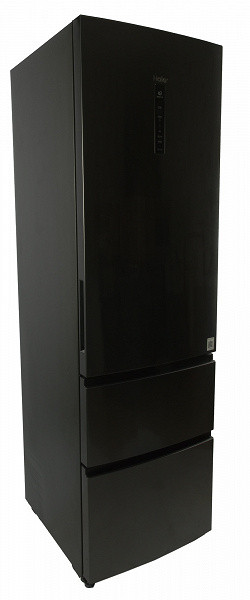
The design of the shelves in this model is attractive due to its thoughtfulness and the ability to customize for convenient storage. Thanks to the folding drink holder and the unique transformable third shelf, even large items can be conveniently placed in the refrigerator. The pull-out drawers of the freezer compartment also turned out to be easy to use.
In addition to the basic functionality, there are the Vacation, Super Freeze, and Super Cool modes. The Vacation mode helps preserve food and save energy during the long absence of the owners, while Super Freeze and Super Cool allow you to quickly freeze or cool a significant amount of food.
A convenient mobile application allows you to configure the device from anywhere in the world. It not only duplicates the controls, but also allows you to plan the cooling time of your favorite drinks. However, unfortunately, the application does not track the shelf life of products, and the user will have to monitor this on their own.
Pros:
- Efficient inverter compressor
- Attractive appearance
- Convenient and unusual design of freezer compartment drawers
- High configurability of shelves and drawers
- Temperature control in the freshness zone
- Total NoFrost
- Control via mobile application
Cons:
- Relatively high energy consumption
- Not too long storage time for products during power outages










